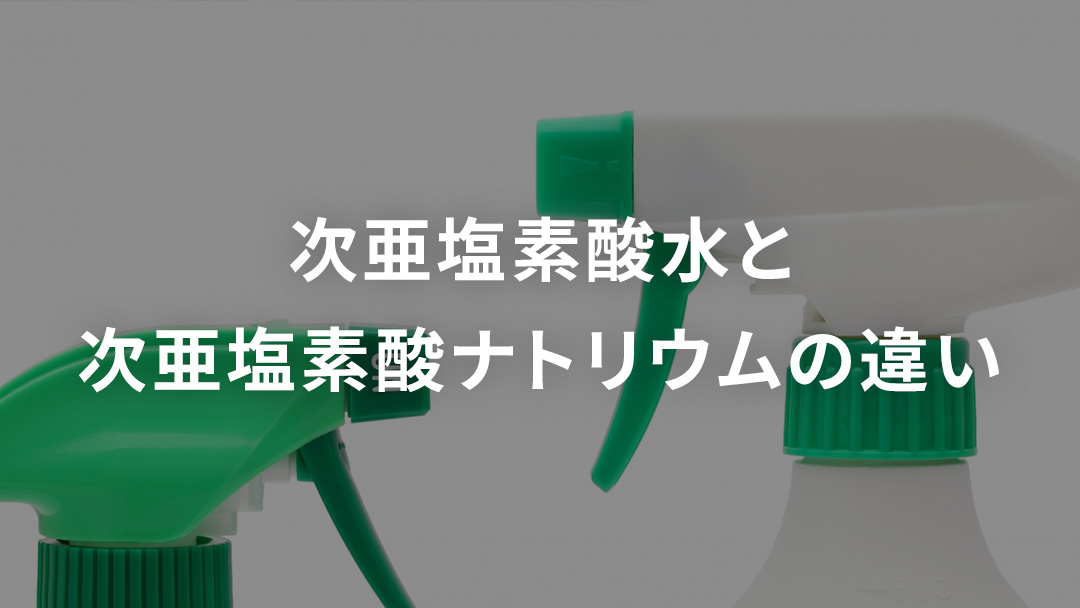お知らせ・お役立ち便覧 NEWS
【特設】コロナウイルス関連
2020.06.05
次亜塩素酸水と次亜塩素酸ナトリウムの違い

目次
独立行政法人 製品評価技術基盤機構(NITE)が、5月29日、新型コロナウイルスの消毒を目的として利用されている「次亜塩素酸水」について、「現時点においては有効性は確認されていない」という中間報告が出されました。
昨今の日本では、いたるところに新型コロナウイルス対策として「次亜塩素酸噴霧器」が置いてあります。新型コロナウイルス対策で効果があるかは分からないけれど気休め程度で使用する人はともかく、これを使えばその空間の新型コロナウイルスに効果があるぞと信じて購入し使用していた人は、報道をみてさぞやがっかりされたことでしょう。
ウイルスの分類
ここでおさらいです。ウイルス粒子には下記の3種類の基本構造があります。
(A)ウイルス粒子がエンベロープ(外膜)を持たないタイプ
このタイプには、ポリオ(小児麻痺)ウイルスやアデノウイルス、ノロウイルスなどのウイルスが該当します。
(B)ウイルス粒子がエンベロープ(外膜)を持つが、核酸にタンパク質がついていないタイプ
ヘルペスウイルスが該当します。
(C)ウイルス粒子がエンベロープ(外膜)を持ち、核酸にタンパク質がついているタイプ
インフルエンザウイルスやコロナウイルス、麻疹ウイルスなどがこのタイプです。今回の新型コロナウイルスも構造的にはこのタイプに該当します。
加えてさらに2つの分類があります。
(1)核酸がDNAのウイルス
(2)核酸がRNAのウイルス
インフルエンザウイルスやノロウイルスはRNAウイルスです。また、今回の新型コロナウイルスもRNAウイルスです。
ここでお気づきの方もおられるかと思いますが、新型コロナウイルスとインフルエンザウイルスの粒子構造は似ています。そのため、インフルエンザウイルスに効くものは、新型コロナウイルスにも効果があって、酸性電解水(次亜塩素酸水)は効果があるだろうと推測され、現状に至るわけです。
勿論その推測をもとに、経済産業省は新型コロナウイルスに効く可能性がある消毒方法や製品として、以下の3分野品を選定し、NITEに検証試験を委託しました。
- 界面活性剤(台所用洗剤等)
- 次亜塩素酸水(電気分解法で生成したもの)
- 第4級アンモニウム塩
その結果が冒頭の5月29日付の中間報告でした。次亜塩素酸水の効果は現時点では確認できなかったのです。
今回話題の「次亜塩素酸水」(電解水)(HOCl)は、殺菌成分の「次亜塩素酸」が含まれており、新型コロナウイルスに対する効果はまだ「?」ですが、インフルエンザウイルスや旧型(?)のコロナウイルスには効果があるため、食品の消毒や物品の除菌などに用いられています。
一方、コメントでもちらほら見受けられたのが「次亜塩素酸ナトリウム(ソーダ)」(NaClO)です。こちらは漂白剤としても活躍しています。次亜塩素酸ナトリウム液は非常に強いアルカリ性です。次亜塩素酸ナトリウムにも、殺菌成分である「次亜塩素酸」が含まれています。
次亜塩素酸水と次亜塩素酸ナトリウムの違い
2つの違いは3つあります。1つずつ解説していきます。
①pH(ペーハー)が異なる
前章でもちらっと触れましたが、次亜塩素酸水は弱酸性ですが、次亜塩素酸ナトリウムは強アルカリです。
お肌が弱酸性というのは有名なお話ですが、次亜塩素酸水はお肌と近しいpHなので、皮膚へのダメージは少なく済みます。
アルカリ性のものを触って手がヌルヌルするのは皮膚へのダメージで皮膚が溶けているのが原因です。次亜塩素酸ナトリウムでもこのような現象になりますので、皮膚への塗布は厳禁です。
②使用方法が異なる
次亜塩素酸水はそのまま使用するものですが、次亜塩素酸ナトリウムは薄めて使うのが一般的です。
希釈例(原液12%濃度)
用途 有効塩素濃度 希釈倍率(例) 水(飲料水、プール、排水)の除菌 約0.8ppm 約140,000倍(100Lの水に対して約0.7ml) 食器類の除菌 約100ppm 約1,200倍(100Lの水に対して約75ml) 生野菜・果実類の除菌 約100ppm 約1,200倍(100Lの水に対して約75ml) 浴室、浴槽、便器などの除菌 約600ppm 約200倍(100Lの水に対して450ml) しみ抜き・漂白(酒、果汁、インキ等) 600~2000ppm 60~200倍(100Lの水に対して450~1500ml)
③殺菌成分の形態が異なる
次亜塩素酸水に含まれる遊離塩素は不安定なHClOの形で含まれています。そのため、低濃度でも殺菌効果を発揮しますが、有機物に触れるとすぐに分解されてしまうので、調理器具や医療器具の殺菌を行う際には、次亜塩素酸水が大量に必要になります。手に塗布する際も、左手に塗布した次亜塩素酸水を右手にもいきわたらせるころには、分解されてしまっていますので、直に大量の次亜塩素酸水を塗布する必要があります。
次亜塩素酸ナトリウム水溶液は、アルカリ性のため遊離塩素が安定したClO-の形で多く含まれています。安定しているため、殺菌効果を出すのに次亜塩素酸水と比べ高い濃度が必要になります。一方で安定していることによって、殺菌効果の持続力があるため、拭き掃除などでの殺菌に使用されます。
おまけ
次亜塩素酸水と次亜塩素酸ナトリウムについての違いは簡単にまとめてみましたが、「次亜塩素酸カルシウム」というものも存在します。これは固体で、水に溶かすと弱アルカリ性を示します。
日本では一昔前、先生が学校のプールに「カルキ」と呼ばれる白い錠剤を巻いていたのを覚えていらっしゃる方もいると思いますが、この白い錠剤が「次亜塩素酸カルシウム」です。カルキは、水酸化カルシウム(=石灰)に塩素を吸収させて作ります。この塩素が、プール内の雑菌の繁殖を抑える役割を果たしていました。
昨今では、管理のしやすい液体の次亜塩素酸ナトリウムが主流になっています。水道水の殺菌消毒も次亜塩素酸ナトリウムです。固体の次亜塩素酸カルシウムと違い、次亜塩素酸ナトリウムは液体なので水に溶けやすいため濃度調整がしやすいのです。
水道水の消毒について
日本の水道法では、『水の消毒は塩素によることを基本とする』と定められていて、その中でも日本が水道水への使用を認めているのは「次亜塩素酸ナトリウム」「次亜塩素酸カルシウム」「液化塩素」の3つです。現在水道水を殺菌消毒するために使われているのは、次亜塩素酸ナトリウムです。
結論
次亜塩素酸水の新型コロナウイルスへの効果はまだ「?」ですが、次亜塩素酸ナトリウムはどうか? という疑問に対してはまず次亜塩素酸ナトリウムは新型コロナウイルスに効果があると厚生労働省の文書で明記されています。(下記URL参照)
https://www.mhlw.go.jp/content/000617981.pdf
ですが強アルカリのため、皮膚への塗布はできないので、手指消毒にはお使いいただけません。消毒時は手袋を着用するように、上のリンク先にも明記があります。また、金属を腐食することもありますので、アルコール消毒と使い分けてご使用になるのが良いかと思います。
カテゴリーから探す
キーワードから探す